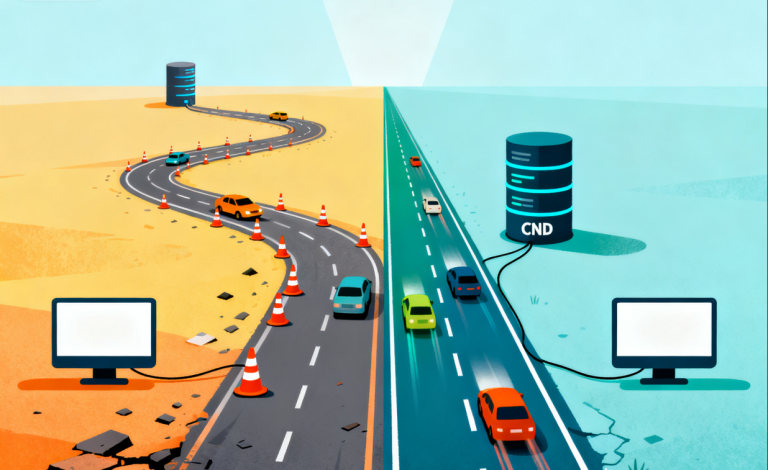
It’s one of the most frustrating feelings in the world, isn't it? You click on a link, ready to browse or buy, and you’re met with a blank page. The little loading spinner taunts you. Five seconds pass. Then ten. Your patience evaporates, and you hit the back button. For a website owner, this is a moment of pure, sudden panic. You’ve put so much time and effort into your website, but it’s failing at the most basic job: showing up. You’re left with a confusing mess of questions: Why is it so slow? Is it my server? My code? My internet connection? The truth is, the culprit is often much simpler than you think, and the solution is far more elegant. Your website isn’t slow because it’s bad; it’s slow because it’s being asked to do an impossible job.
Think of your website like a popular restaurant with a single, small kitchen. When a customer orders a meal, the waiter (the internet request) goes all the way to the kitchen, gives the order, and then waits for the food to be prepared before bringing it back. Now, imagine if thousands of customers from all over the world suddenly start ordering at the same time. The kitchen gets overwhelmed. The waiters get stuck in long queues. And the customers at the far end of the city have to wait even longer because their waiter has a longer journey. This is a perfect metaphor for what happens to your website without a Content Delivery Network (CDN).
A CDN isn't a silver bullet that magically fixes every problem, but it addresses the most common and critical reasons your website is slow. It’s a sudden, transformative leap that turns a single, overwhelmed kitchen into a global network of well-stocked food trucks, ready to serve customers instantly, wherever they are.
The Real Reason Your Website Is Slow
You might blame your hosting plan or your website's code, but the real enemy is often distance and traffic.
The Problem of Physical Distance: The internet, despite its name, is not an ethereal cloud. It's a vast network of physical cables, servers, and data centers. Your website is physically located on a server in one of these data centers—let's say it's in Virginia, USA. Now, what happens when a user in Tokyo, Japan, tries to access your website? Their request has to travel thousands of miles across continents and oceans. Each stop along that journey—every router, every network hop—adds a tiny bit of latency. This "round-trip time" for data adds up, making your website feel sluggish even before it starts to load. This is a problem you can’t fix with a bigger server; it's a physical limitation.
The Problem of Server Overload: We've all seen the traffic jam analogy. When a popular blog post goes viral or you launch a major sales event, your single origin server is suddenly hit with thousands of simultaneous requests. It can’t handle the load. It starts to slow down, and in the worst-case scenario, it crashes. This isn’t a problem with your website's code; it’s a problem of resource limitations. Your server is trying to serve the same exact file—say, a product image—to thousands of different people at the same time, a task it was never designed for.
The Problem of Non-Optimized Content: Most of your website's data isn’t dynamic. It’s static. Things like your logo, product images, CSS stylesheets, and JavaScript files don’t change very often. But without a CDN, every time a user visits your site, their browser has to download all of these files again. These files are often large and can take a long time to load, especially on mobile devices or slower connections. This is like your restaurant sending a brand new menu with every single meal, even though the menu is the same every day. It's a massive waste of time and resources.
How a CDN Solves These Problems
A CDN is a powerful solution because it directly tackles these fundamental issues. It doesn’t just make your website faster; it completely changes the way your content is delivered.
It Destroys the Distance Problem: A CDN is a global network of servers, strategically located in data centers around the world. Your website’s static content is cached—or stored—on these servers. When a user in Tokyo visits your site, their request is automatically routed to the closest CDN server in that region. The files travel a few dozen miles instead of thousands, and they arrive almost instantly. It's like having a local, well-stocked storefront in every major city. The physical distance that once crippled your performance is now completely irrelevant.
It Eliminates Server Overload: By serving static content from its distributed network, a CDN offloads the vast majority of traffic from your origin server. Your server is no longer the single kitchen trying to serve everyone; it's just the central depot that sends out the initial recipes. The CDN servers handle all the meal preparation and delivery. This frees up your origin server to focus on what it does best: handling dynamic requests, processing orders, and running your core business logic. When your site goes viral, the CDN absorbs the traffic spike, ensuring your website stays online and performs flawlessly.
It Delivers Content with Intelligence: A CDN is much more than a simple file storage service. It’s an intelligent delivery system. It can automatically compress images and files to make them smaller and faster to download. It can deliver content via modern protocols like HTTP/2 and HTTP/3. It can even make your website more secure by acting as a shield against DDoS attacks, filtering out bad traffic before it ever reaches your server. It’s a complete optimization package that makes your website not just faster, but smarter and safer.
In the end, a slow website is an invisible killer for your business. It hurts your SEO, damages your brand reputation, and directly impacts your sales and conversion rates. The confusion around why a website is slow can feel overwhelming, but the sudden realization is that the problem isn't your website; it's the old, inefficient way it’s being delivered. A CDN takes that frustration and replaces it with a fast, seamless, and reliable user experience that will keep your customers coming back for more. It’s the single most powerful investment you can make in your website’s performance and your business's future.

